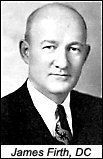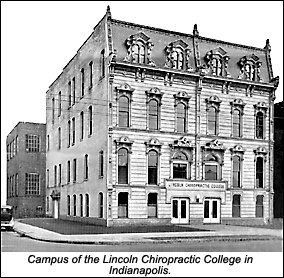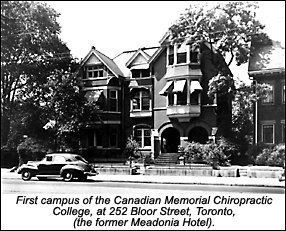Spearheaded by burgeoning scientific and clinical research literature, psychedelics have reached a level of media coverage and popular interest that has not been seen for over half a century. By “psychedelics,” we are referring to the unique class of substances that includes psilocybin (the active compound found in so-called “magic mushrooms”), LSD, dimethyltryptamine (DMT), ayahuasca, 5-MeO-DMT, and mescaline – each of which occurs in the natural world (except for LSD, which is a semi-synthetic compound).
Chiropractic Education, 1945: A Snapshot, Part II
(Editor's note: Part I of this article appeared in the January 1 issue,available at www.chiroweb.com/archives/21/01/11.html. Part II is a continuation of a report of faculty members' experiences during a tour of the National, Palmer, Logan and Lincoln campuses, dated September 10, 1945.)
Logan Basic College of Chiropractic
Dr. Vinton F. Logan met the committee upon arrival at the grounds of the college. He first took us around the grounds and school, and then to his office for a discussion. He also showed us the plans for his new college, which is to be started this October. At twelve o'clock, he spoke to the entire student body by means of a P.A. system (which is installed in every room), and asked them to meet in the largest lecture room. When all were assembled, Dr. Logan introduced the committee to the students, and each one of us was asked to speak to the students. After lunch in the college cafeteria, we met again in Dr. Logan's office, and continued our discussion until almost six o'clock.

Faculty: Every member of the faculty is a chiropractor; some who are teaching special subjects have other degrees as well, but Dr. Logan stressed the point that all his staff must be thoroughly versed in chiropractic and also have a working knowledge of all the other subjects taught. The principles of chiropractic are explained to all the office staff, as well, so that everyone in any way connected with the school has a good knowledge of what chiropractic is and what it can do. We noticed a very strong feeling of cooperation and goodwill among the staff and students, and enthusiasm for chiropractic, which is very commendable. Dr. Logan himself has a well-founded belief in chiropractic and is a great inspiration to his students. He is trying in every way to bring chiropractic up to the high standard and reputation this remarkable science deserves.
Course: The school day is from eight o'clock in the morning until one o'clock in the afternoon, six days a week. The study of physics and biodynamics is an essential part of the course. Palpation is studied in conjunction with X-ray. There is a very extensive X-ray course given, and upon graduation, a certificate of proficiency in roentgenology is awarded.
The students are given a very efficient course in office administration and business. A nine-month course for office assistants is also given.
The subjects given in the first semester are of such a nature that they may be taken at any time during the entire course or at the end of it, so that the freshmen starting in the second semester (February) may join the other freshmen without sacrificing continuity of curriculum. In September, three years following, the September class graduates, but the February class still has three months to run, and so they take at this time the subjects that the September freshmen class received in their first three months at college. This system is a result of long experimentation, and has been proved to be the best procedure, as it saves time, money and confusion.
There are no Ph.C. degrees given and only three cum laude standings are awarded at each graduation.
Clinic: There is only one clinic, which is a pay clinic. This is compulsory for the students, who must complete 1,000 hours of internship. Credit is only given for actual treatments. Two treatments are equal to one hour. The students are not paid for work done in the clinic. Only the best adjusting tables are used in the clinic, and these are being constantly renewed as the students are allowed to buy them at reduced cost when they graduate.
The clinic is open from 1-4:30 and from 6-8:30 on Monday, Tuesday, Thursday and Friday. Upon entering the clinic, a patient is given a thorough examination for which he is charged $15. This includes all X-rays and tests performed. For treatment, the charge is $25 per month for four treatments a week.
Upon entering the college, every student is X-rayed, and throughout his college course he is given regular treatments in the clinic, to improve his health, and in consequence, every graduate is healthier than he ever was before, and is thus a very good advertisement for his occupation. Every student is given a duplicate set of all X-rays he has taken during his course in X-ray, in which he must take at least 50 pictures to complete his work.
Finances: The charge for tuition is $35 a month, and if a man and wife are taking the course together the wife is charged half tuition. The dormitory income is $3.50 to $4.00 per person per week.
The students do most of the work around the college, under the direction of a maintenance man. The students are paid so much an hour for their work. Most of the students earn their living while they are attending college, and the school helps in every way possible to secure suitable employment for its students either at the college itself or in the city of St. Louis.
There is a small factory on the campus where lifts for shoes are made, and view boxes for X-rays and shoe scales. A few students can earn their tuition working here. Meals are served in the cafeteria six days a week for $5.35 per week.
Tour of the Building: The college is situated on the outskirts of St. Louis in a grove of lovely oak trees. The main building was an old white frame house that has been remodeled to suit the purposes of a school. The rooms are painted light cream in colour and are very well-lighted and airy. The seats have widened arms on which to rest books for writing. All the equipment is the best and most modern obtainable. In the main hall, there is an automatic clock and bell for calling classes.
The dissection room is in a separate building, which is very well-ventilated. There is also a special recreation cottage containing a stone fireplace, a piano, a jukebox, and a large mirror along one wall so the students can see themselves and check on their own posture. When necessary, this is also used for a classroom. In summer, for one period a week, the students are given time for exercise. There are tennis courts next to the recreation building. In the wintertime for this period, the students gather in the recreation cottage for a "sing-song."
There is a girls' dormitory building on the campus that houses most of the women students. Nearby is a trailer camp for married couples to live. The top floor of the college building is used as a dormitory for the men students.
The chemistry laboratory is small but contains all the necessary equipment. In the new building there is to be a completely equipped chemistry and physics laboratory. Throughout the entire building fluorescent lighting is used, and every room is well lighted.
Lincoln Chiropractic College
Though Dr. James Firth was very busy and he had patients waiting for him in the clinic, he took two hours of his time to show us through his college and answer all of our questions.
Faculty: Not all the members of his faculty are chiropractors. Chemistry and its allied subjects are taught by the professor of chemistry at the Indiana Medical School, and the students receive the same course that is given to the medical students.
Course: Classes start at eight o'clock in the morning and continue until noon. In the afternoon, classes are held from 1:30 until 3:30. There are no classes on Saturday. The entire course covers four years of eight months each.

Clinic: Patients at the clinic pay $5 per month; of this, $3 goes to the student and $2 to the school. Examination and treatments are given by the students under very strict supervision. Interns at the clinic stay in a study room until their patient comes at which time they are paged. Credit is given for hours spent in the clinic, not on the number of adjustments.
Finances: The tuition fee is $140 per semester of 16 weeks. In the clinic, there is an extra charge for special examination and any laboratory tests. It did not appear that the college had any other income besides its tuition fees and income from the clinic.
Tour of the Building: The building is very large. It was formerly occupied by the Dental College of Indiana University. The classrooms are exceptionally large and well-lighted.

The chemistry laboratory is very well equipped, more so than any other we had seen. The clinic contains booths open at one end, so that the patients cannot see each other but the instructor can walk down the aisle and easily observe his students at work. In the clinic there is a posture check machine, which records electronically the balance of weight over each portion of each foot.
The cadavers used in dissection are embalmed with glycerin and dye injected, and can be left in the classroom all term without any offensive odour. There is an incinerator for discarded parts in one corner of the dissection room.

Recommendations
After personally viewing these four colleges and talking to various members of the staffs, and in some cases talking to the students themselves, the committee feels that the following recommendations should be incorporated into the Canadian Memorial Chiropractic College, in order that we may give our students and graduates the best possible knowledge and practice of chiropractic, and to build up the standard and reputation of chiropractic to the high standard that this science merits:
- The first semester of the freshman year should include only those subjects that can be taken at any time during the four-year course. Thus, in February, the new group entering can be joined with the September freshmen and both groups follow along together for the remaining three-and-a-half years of the course. At this time the September group will graduate, but the February group will still have 4.5 months to go, and at this time they will take the subjects that the September group got in their first semester. Thus, we do not sacrifice the continuity of the curriculum, and the whole school programme is simplified.
- All faculty members must be sympathetic and understanding toward the principles of chiropractic, and eventually have all faculty members chiropractors.
- All students should be examined and X-rayed upon entering the college and given adjustments throughout their college years.
- Means should be found for supplementing the income of the college, preferably in some type of work in which some of the students can be employed, such as making lifts for shoes, or possibly starting a small laundry for laundering white coats and office gowns.
- As soon as possible, an active alumni should be formed.
- After the curriculum has been decided upon, consideration should be given to having one period a week for discussion and recreation.
- Consideration should be given to eventually starting a course for office assistants and chiropractic nurses.
- Postgraduate courses should be taught in the summer months for practitioners.
- Only the best equipment available should be bought for teaching purposes in the college.
Joseph Keating Jr., PhD
Phoenix, Arizona
jckeating@aol.com



